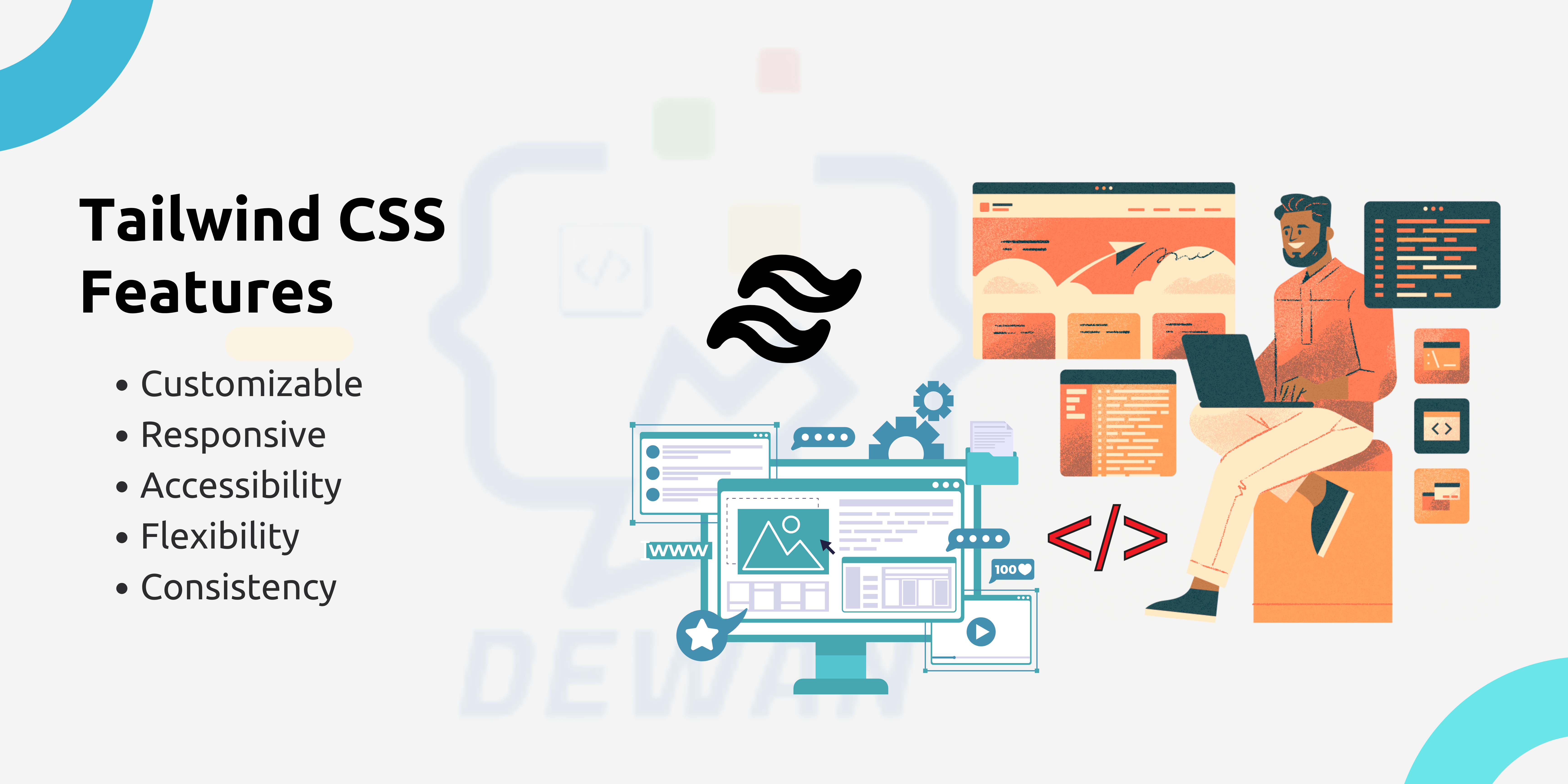
Introduction
Tailwind CSS is a utility-first CSS framework that gives a singular approach to styling web programs. unlike traditional CSS frameworks that offer pre-designed components, Tailwind CSS focuses on supplying low-degree utility instructions that can be composed together to build custom designs. This method offers developers an excessive diploma of flexibility and management of their patterns whilst maintaining a consistent and cohesive layout gadget. Tailwind CSS is relatively customizable, permitting builders to configure everything from colorings and spacing to typography and breakpoints. Its recognition has grown hastily among developers who value its simplicity, performance, and capability to streamline the styling method in net development initiatives.
Imposing Tailwind CSS in a venture includes numerous steps to install and make use of its application-first technique for styling. here's a trendy guide to enforcing Tailwind CSS.
Install Tailwind CSS
To put in Tailwind CSS on your project, you could use npm or yarn. here is a step-by-step manual.
Create a New Mission (If You Have Not Already)
In case you don't have a present assignment, create a brand new listing on your undertaking and navigate into it.
Initialize your project
If you haven't already initialized your project with npm or yarn, you can do so with.
Install Tailwind CSS
Install Tailwind CSS and its dependencies using npm or yarn.
Create a configuration file
Generate a Tailwind CSS configuration document (tailwind.config.js) in your undertaking directory.
You may also like to read : Tailwind CSS Implementation
Create your CSS file
Create a CSS file where you will import Tailwind CSS and write your styles. For example, create a file named styles.css.
Build your CSS
Add a build script to your package.json file to process your CSS file and compile Tailwind CSS classes into standard CSS, for example.
Include your CSS file
Include your output CSS file (e.g., output.css) in your HTML file or project as needed.
Start using Tailwind CSS
You could now start the usage of Tailwind CSS utility classes on your HTML documents to style your venture.
Keep in mind that these steps provide a basic setup for using Tailwind CSS. You may need to configure Tailwind CSS further based on your project requirements.
Create a Configuration File

To create a Tailwind CSS configuration record and put in force Tailwind CSS in your venture, observe those steps.
Create a Configuration File
Generate a Tailwind CSS configuration record (tailwind.config.js) in your project directory.
You may also like to read : Trello Project Management
Configure Tailwind CSS
Open the tailwind.config.js document in your code editor. This document permits you to customize various components of Tailwind CSS, consisting of hues, fonts, spacing, breakpoints, and more. Regulate the configuration to fit your task's design requirements.
Create Your CSS File
Create a CSS file (e.g.,styles.css)where you will write your styles using Tailwind CSS classes. Import Tailwind CSS at the beginning of your CSS file.
Build Your CSS
Add a build script to your package.json file to process your CSS file and compile Tailwind CSS classes into standard CSS.
Run the build script to generate your final CSS file.
Include Your CSS File
Include the output CSS file (e.g.,output.css) in your HTML file or project as needed.
Start Using Tailwind CSS
You can now begin using Tailwind CSS application instructions for your HTML files to fashion your venture.
by following those steps, you can create a Tailwind CSS configuration document and enforce Tailwind CSS on your assignment, allowing you to fast-fashion your undertaking using its utility-first method.
Include Tailwind CSS in your CSS File
To include Tailwind CSS in your CSS file, you need to import the bottom, additives, and utility patterns. here's how you could do it to your CSS file (e.g.,styles.css).
Ensure that your CSS file is processed by a build tool like Webpack or PostCSS to resolve the imports and generate the final CSS file. This CSS file will contain all the Tailwind CSS styles ready to be used in your project.

Build Your CSS File
To include Tailwind CSS in your CSS file and build it for use in your project, follow these steps.
Create Your CSS File
First, create a CSS file (e.g.,styles.css) where you will include Tailwind CSS.
Build Your CSS File
You will need a build technique to compile your CSS report with Tailwind CSS. In case you're the use of a construct device like Webpack, Parcel, or PostCSS, you can configure it to technique your CSS file.
Using PostCSS (with npm)
If you're using PostCSS with npm, you can install the necessary plugins.
Create a PostCSS Config File
Create a postcss.config.js report for your undertaking root with the subsequent configuration.
Build Your CSS with PostCSS
Add a build script to your package.json to process your CSS file.
Run the Build Script
Run the build script to compile your CSS file with Tailwind CSS.
Include the Built CSS File
Finally, include the built CSS file (e.g.,dist/styles.css) in your HTML file or project to apply the styles to your project.
With the aid of following these steps, you may encompass Tailwind CSS to your CSS file and build it for use on your project, ensuring that your styles are well processed and carried out to your HTML.
Build your CSS
To build your CSS report with Tailwind CSS, you could use PostCSS at the side of the Tailwind CSS plugin. here is a step-by-step manual.
Install PostCSS and Tailwind CSS
If you have not already installed PostCSS and Tailwind CSS, you may accomplish that using npm or yarn.
Create a PostCSS Configuration File
Create a postcss.config.js report in your undertaking's root directory. This record will configure PostCSS to apply the Tailwind CSS plugin.
Create Your CSS File
Create a CSS file (e.g.,styles.css) where you will include Tailwind CSS.
Build Your CSS
Use the PostCSS CLI to build your CSS file. you may do this via going for walks the subsequent command to your terminal.
This command processes your styles.css file with PostCSS, including the Tailwind CSS styles, and outputs the result to output.css.
Include Your Built CSS File
Include Your Built CSS File: Finally, include the built CSS file (output.css) in your HTML file or project to apply the styles to your project.
By following those steps, you could build your CSS report with Tailwind CSS with the use of PostCSS, allowing you to encompass Tailwind CSS styles for your task.
Use Tailwind CSS Classes
To apply Tailwind CSS training for your HTML documents, and genuinely practice the instructions for your elements. Tailwind CSS affords a wide range of application instructions for styling factors. here's a primary example.
In this situation, the bg-blue-500, text-white, font-ambitious, py-2, px-4, and rounded lessons are all Tailwind CSS application lessons. those instructions fashion the element to have a blue historical past, white textual content, ambitious font, padding of 2 gadgets at the y-axis and 4 devices at the x-axis, and rounded corners.
You may similarly use Tailwind CSS training to fashion different elements on your HTML file. refer to the Tailwind CSS documentation for a complete listing of available application instructions and their respective styles.
Customize Tailwind CSS
Customizing Tailwind CSS allows you to tailor the framework to match your undertaking's layout necessities. Tailwind CSS presents a configuration file (tailwind.config.js) wherein you can outline custom shades, fonts, spacing, breakpoints, and more. here's how you can customize Tailwind CSS.
Generate a Configuration File
If you have not already generated a Tailwind CSS configuration file, you can do so using strolling.
Edit the Configuration File
Open the tailwind.config.js file in your project's root directory. This file exports a JavaScript object where you can customize various aspects of Tailwind CSS.
For example, you can add custom colors or extend existing colors.
Using Customizations
After customizing Tailwind CSS, you can use your customizations in your HTML or CSS files. For example, you can use your custom color in an HTML element.
Build Your CSS
After making modifications to your tailwind.config.js report, you want to rebuild your CSS document to use the customizations.
Other Customizations
Tailwind CSS permits for lots of her customizations, together with including new fonts, modifying spacing, configuring breakpoints, and more. refer to the Tailwind CSS documentation for a comprehensive list of customization options and the way to use them.
through customizing Tailwind CSS, you may create a unique layout gadget in your challenge whilst nevertheless leveraging the software-first method that Tailwind CSS provides.
Optimize for Production

To optimize your Tailwind CSS for production, you could use the purge option to eliminate unused patterns from your final CSS report. This reduces the file length and improves the loading time of your internet site. here's how you can optimize Tailwind CSS for manufacturing.
Update Your Build Script
Modify your build script in your package.json file to include the purge option when building your CSS file.
Run the Build Script
Run the build script to generate your final optimized CSS file.
Include Your Optimized CSS File
Finally, include the optimized CSS file (output.css) in your HTML file or project as you normally would.
By adding the NODE_ENV=production environment variable to your build script, Tailwind CSS will automatically purge unused styles, resulting in a smaller and more optimized CSS file for production use.
Stay Updated
It's crucial to stay updated with the present-day model of Tailwind CSS to benefit from new functions, upgrades, and trojan horse fixes. here's how you can live updated with Tailwind CSS.
Check the Release Notes
Regularly test the Tailwind CSS launch notes at the legitimate internet site or GitHub repository. the discharge notes offer details about every release, inclusive of new functions, adjustments, and bug fixes.
Follow Tailwind CSS on Social Media
Follow the official Tailwind CSS accounts on social media platforms like Twitter or LinkedIn. The Tailwind CSS team often posts updates, announcements, and tips on these platforms.
Join the Tailwind CSS Community
Join the Tailwind CSS community on platforms like GitHub Discussions, Reddit, or Discord. These communities are great places to stay updated, ask questions, and engage with other Tailwind CSS users.
Subscribe To The Publication
Enroll in the Tailwind CSS newsletter to get hold of updates, guidelines, and news directly in your inbox.
Update Your Project Regularly
When a new edition of Tailwind CSS is released, update your mission's dependencies to apply the trendy version. you can do that with the usage of npm or yarn.
Test Updates in a Development Environment
Earlier than updating Tailwind CSS in a manufacturing environment, and testing the updates in a movement environment up to date ensure compatibility is up to date undertaking.
with the beneficial useful resource up-to-date staying with the version updated Tailwind CSS, you may take advantage of modern-day features and improvements at the same time as retaining your project cozy.
Conclusion
In the end, imposing Tailwind CSS gives an effective and green manner to style your net initiatives. Its application-first method permits for fast development and clean customization, making it perfect for initiatives of all sizes. By using following the installation and customization steps, you could tailor Tailwind CSS to suit your layout necessities even after taking advantage of its widespread set of utility classes. Staying updated with the trendy model of Tailwind CSS guarantees that you may take benefit of the latest capabilities and enhancements, preserving your initiatives as contemporary and efficient. standard, Tailwind CSS offers a strong foundation for growing elegant and responsive web interfaces.
